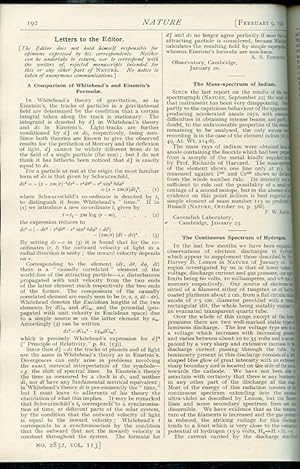Eddington Kramers Hendrik Sherrington Sir (1 results)
Product Type
- All Product Types
- Books (1)
- Magazines & Periodicals
- Comics
- Sheet Music
- Art, Prints & Posters
- Photographs
- Maps
-
Manuscripts &
Paper Collectibles
Condition
- All Conditions
- New
- Used
Binding
- All Bindings
- Hardcover
- Softcover
Collectible Attributes
- First Edition
- Signed
- Dust Jacket
- Seller-Supplied Images
- Not Printed On Demand
Seller Location
Seller Rating
-
A Comparison of Whitehead's and Einstein's formulas" (Eddington p. 192) WITH "The law of dispersion and Bohr's theory of spectra (Kramers p. 673-674) WITH Problems of Muscular Receptivity" (Sherrington, pp. 892-894; 929-932); "The Origin of the Solar System (Supplement, pp. 329-340) in Nature 113, 1924
Published by Macmillan, London, 1924
Seller: Atticus Rare Books, West Branch, IA, U.S.A.
First Edition
1st Edition. Full volume. FIRST EDITION OF EDDINGTON'S PAPER PROPOSING A CHANGE IN COORDINATE SYSTEMS THAT WILL ELIMINATE THE SCHWARZSCHILD SINGULARITY. The physical significance of this singularity, and whether this singularity could ever occur in nature, was debated for many decades" until the possibility of a black hole was accepted in the second half of the 20th century (Wikipedia). In this paper, Eddington made a coordinate change which transformed the Schwarzchild metric into a form which was not singular, thereby rejecting Schwarzchild's implication of relativistic quantum mechanics rather than accept the possibility of black holes. ALSO INCLUDED: FIRST EDITION OF KRAMERS' LAW OF DISPERSION, A FORMULATION THAT CAME CLOSE TO PROVIDING A FORMULATION OF QUANTUM MECHANICS, BUT DID NOT DO SO. Prior to the development of matrix mechanics, a number of papers on the quantum theory of radiation and its dispersion came close to providing a formulation of quantum mechanics, and Kramer's paper is one of those. Electromagnetic radiation did not fit easily into the framework of the old quantum theory. "The task Kramers set himself was to fit dispersion phenomena into this framework, that is, to use the correspondence principle to derive expressions describing the reaction of material media to electromagnetic radiation. In face, he successfully derived such formulae which, moreover, contained only observable quantities and no longer contained attributes specific for the multiple periodic systems that he used as his model for the atoms" (Haar, Master of Modern Physics, 26). "The path to quantum mechanics went over radiation theory, involving as an important component attempts to construct quantum-theoretical dispersion theories on the basis of difference rather than differential equations" (Kragh, Quantum Generations, 161). Kramers's dispersion theory - an expression for the cross-section for scattering of a photon by an atomic electron -- was formulated in the context of the old quantum mechanics, then "introduce[d] quantum theory by invoking. the correspondence principle and first looking at the case of large quantum numbers" (Wikipedia; ter Haar). "Kramers shows [in this paper] that a similar formula should hold in quantum theory. To each possible transition there corresponds a virtual oscillator with an effective value (e2/m) that can be calculated from the transition probabilities. For a transition to a higher level this value is positive but for a transition to a lower level it is negative, an entirely new feature closely related to Einstein's stimulated emission" (CDSB). Kragh argues that Kramers dispersion theory "can be seen as the first decisive step toward the new quantum mechanics" (Kragh,161). ALSO INCLUDED: THE FIRST APPEARANCE IN PRINT OF CHARLES SHERRINGTON'S CLASSIC LINACRE LECTURE, "PROBLEMS OF MUSCULAR RECEPTIVITY". Sherrington was the creator of many of the fundamental concepts of modern neurology, was a skilled experimentalist, and went on to win the Nobel Prize. ALSO INCLUDED: Special Supplement: "The Origin of the Solar System," J. H. Jeans. All other special supplements are also present. CONDITION & DETAILS: London: Macmillan. 4to. (11 x 8.25 inches; 275 x 206mm). Ex-libris bearing the usual markings (though subtle at spine). Full volume. Bound in dark green cloth a bit scuffed at the edge tips. Solidly bound. Clean throughout. Very good condition.


